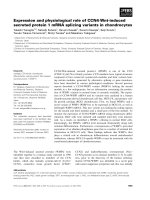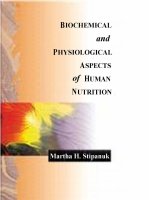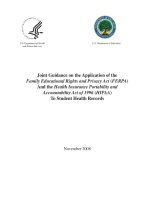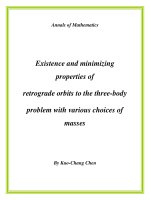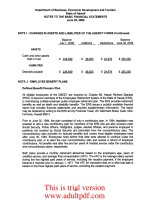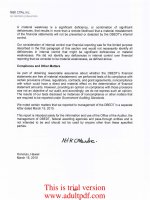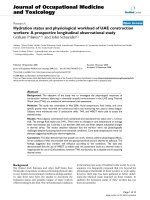Hemato-biochemical and physiological response of barbari kids to different bedding materials during winter
Bạn đang xem bản rút gọn của tài liệu. Xem và tải ngay bản đầy đủ của tài liệu tại đây (345.7 KB, 8 trang )
Int.J.Curr.Microbiol.App.Sci (2019) 8(2): 1829-1836
International Journal of Current Microbiology and Applied Sciences
ISSN: 2319-7706 Volume 8 Number 02 (2019)
Journal homepage:
Original Research Article
/>
Hemato-biochemical and Physiological Response of Barbari Kids to
Different Bedding Materials during Winter
Mohit Antil1*, Bhuvaneshwar Rai2, Natesan Ramachandran2,
Chetna Gangwar2 and Arun Somagond1
1
Livestock Production Management division, Indian Veterinary Research Institute
Izatnagar, Bareilly˗243122, India
2
Animal Physiology and Reproduction division, Central Institute for Research on Goats,
Makhdoom, Mathura˗281122, India
*Corresponding author
ABSTRACT
Keywords
Bedding material,
Haematobiochemical,
Physiological,
Barbari goat kids,
Winter season
Article Info
Accepted:
15 January 2019
Available Online:
10 February 2019
The comparative haemato˗biochemical and physiological response to different bedding
materials in Barbari kids was evaluated. Thirty post˗weaned Barbari kids of about three
months age were selected from the institutional flock, which were divided into three
groups viz. group I, II and III with ten kids in each group and were kept on plastic slats,
soil and rubber mats, respectively. Blood samples were taken at monthly interval during
the trial. There was no significant effect of flooring type on the physiological parameters.
The mean values of hemoglobin (g/dl) and hematocrit (%) were 9.00, 8.93, 8.96 and 22.04,
21.68, and 21.95, in group I, II and III, respectively. The values of RBC, WBC,
lymphocytes, monocytes and granulocytes counts were 15.36, 14.73, 14.97 (m/mm3) and
14.43, 12.66, 13.71 (m/mm3) and 41.56, 46.03, 46.37 (%) and 4.82, 5.23, 5.28 (%) and
53.61, 48.74 and 48.32 (%), in group I, II and III respectively. The mean total protein,
albumin and globulin values were 6.85, 6.45, 6.34 (g/dl) and 2.59, 2.46 and 2.42 (g/dl) and
4.25, 3.98 and 3.91 (g/dl) in group I, II and III, respectively. The mean values of plasma
glucose, triglycerides and cholesterol were 63.63, 66.32, 70.14 (mg/dl) and 90.29, 96.90,
90.51 (mg/dl) and 82.49, 82.94 and 86.51(mg/dl) in group I, II and III, respectively. The
concentration of glucose was comparable (P>0.05) among group I and II and also among
group II and III, whereas significantly different (P<0.05) among group I and III. The mean
values of total protein in group I was significantly higher (P<0.05) than group II and III.
The mean values of triglycerides were significantly higher (P<0.05) in group II as
compared to group I and III.
Introduction
One of the most coherent reasons for
preference of goats, as compared to other
domestic species, among small and marginal
farmers of India for their livelihood is their
adaptability to wide range of climatic
conditions (Devendra, 1990; Rekib, 1998).
Goats are well-adapted to all types of
environmental severities and exhibit superior
performance over the other domesticated
ruminants (Shkolnik and Silanikove, 1981;
1829
Int.J.Curr.Microbiol.App.Sci (2019) 8(2): 1829-1836
King, 1983). The survival of goats at very
high as well as very low temperatures has
been ensured by their well-developed
adaptive mechanisms. However, despite their
adaptability to climatic adversities, thermal
stress often results in reduction of their
productivity (Al-Tamimi, 2007).
The main problem of kid rearing is the postweaning stress leading to poor growth which
is significantly affected by housing
management (Dadi et al., 2008; Gbangboche
et al., 2006). The poor building designs and
inappropriate microclimates can result in
thermal stress, which significantly affects the
efficiency of animal production (Clark and
McArthur, 1994). Different management
systems can be assessed by using physiology
and hematology as effective tools and
indicators of optimum health and production.
Bedding material is a key component in
housing of kids during winters and can
contribute to enhancement of animal welfare
and health (Behera et al., 2016). Usage of
inadequate bedding during winters, which
consequentially impedes the productivity of
livestock making them prone to different
diseases and parasitic infestation (internal and
external)
In this outset, we aimed to assess and
compare the important hematological and
physiological parameters of Barbari kids
attributing adaptable characters in cold
climates maintained in intensive management
system.
Materials and Methods
The present study was conducted at
Experimental shed complex on ICAR-Central
Institute for Research on Goat (C.I.R.G)
Makhdoom, Mathura, Uttar Pradesh, India.
The climate is hot and semi-arid. Weather
turns colder with winter stretching from
November to February and summer ranges
from May to August month annually.
The animal experiment was initiated in
December 2017 and ended in March 2018. A
total of 30 post weaned Barbari kids (21
males and 9 females) aged 3 months were
selected from institute flock. The kids were
randomly allocated to the two treatment
groups (Plastic slats and rubber mat) and one
control group (Soil floor) on the basis of
similar body weight (Table 1).
Each group comprised of ten kids (7 males
and 3 females). While selecting the animals,
due care was taken to minimize the error by
narrowing down the range of age and live
weights of these experimental animals as far
as possible. The study was conducted for a
period of 90 days duration with an adaptation
period of 1 week prior to recording of
variables. The animals were raised under an
intensive housing system. A single pen (400
feet2) was partitioned equally into 4 parts
using welded wire mesh. The control and
treatment groups were housed in separate
partition of the pen having different bedding
materials. Out of the three groups, second
group served as control.
Physiological parameters
The following parameters were recorded
fortnightly at 9 AM for two consecutive days.
Rectal temperature (RT): The rectal
temperature was recorded by using clinical
thermometer.
Respiration rate (RR): The respiration rate
per minute was recorded by counting the
movement of flank i.e., one outward and
inward movement as one respiration.
Heart rate (HR): The heart rate per minute
was counted by stethoscope or placing the
hand over the heart with minimum
disturbance to the animal.
1830
Int.J.Curr.Microbiol.App.Sci (2019) 8(2): 1829-1836
Blood collection, preservation and analysis
Results and Discussion
Blood samples were collected on 20th, 50th
and 80th day of experimental trail. About 10
ml blood was collected from all the
experimental kids in the morning (before
feeding) by jugular vein puncture. Blood flow
was stopped by applying finger pressure on a
gauze pad on the blood sampling site till the
bleeding was stopped. Blood was taken in
another clean and dry test tube containing
anticoagulant (EDTA) for hematology and
separation of plasma for biochemical
estimation.
Physiological parameters
The blood samples were brought to the
laboratory and centrifuged at 3000 rpm for 15
min to separate plasma collected in small
plastic eppendorf tubes (2 ml) and stored at 200 C for further analysis. The plasma
samples were analyzed for different
biochemical constituents viz. glucose, total
protein, albumin, triglycerides and total
cholesterol
using
diagnostic
kits
manufactured by CogentTM of Span
Diagnostic Ltd. Surat, Gujarat, India. The
procedure provided by the company on kits
leaflet was strictly followed for analysis.
The values of the physiological parameters
have been presented in Table 2. The overall
mean values of respiration rate (RR) were
33.70, 32.00 and 35.13, respectively in Gr-I,
II and III. The values of RR were comparable
(P>0.05) among the groups. The overall mean
values of heart rate (HR) were 124.61, 130.46
and 129.33, respectively in Gr-I, II and III.
The values of HR were comparable (P>0.05)
among the groups. The overall mean values of
RT were 38.82, 38.78 and 38.62, respectively
in Gr-I, II and III. The values of RT were
comparable (P>0.05) among the groups.
Haematological parameters
The mean values of different hematological
parameters studied during the trial have been
presented in Table 3. There was no significant
difference between the groups in white blood
cells (WBC), hemoglobin (Hb), red blood
cells (RBC), hematocrit (HCT), lymphocyte,
monocyte and granulocyte values. The mean
values of hemoglobin (g/dl) and hematocrit
(%) were 9.00, 8.93, 8.96 and 22.04, 21.68,
and 21.95, in Gr-I, II and III, respectively.
Table.1 Dimensions of partitions of pen made for different groups
Group
1
2
3
Bedding material used
Plastic Slats
Soil
Rubber mats
Dimensions of partition
10 feet x 10 feet
10 feet x 10 feet
10 feet x 10 feet
Table.2 Effect of different physiological parameters of kids in different groups
Respiration rate (breaths/min)
Heart rate (beats/min)
Rectal temperature (°C)
A,B,C
Group I
33.70
124.61
38.82
Group II
32.00
130.46
38.78
Group III
35.13
129.33
38.62
Means bearing different superscripts in a row differ significantly (p<0.05)
1831
Mean
33.61
128.13
38.74
SEM
0.71
1.12
0.03
P Value
0.198
0.079
0.082
Int.J.Curr.Microbiol.App.Sci (2019) 8(2): 1829-1836
Table.3 Effect of bedding materials on haematological parameters of kids in different groups
Attributes
Groups
I
II
Red Blood Corpuscles (m/mm3)
14.77
14.26
20 day
15.31
14.83
50 day
15.99
15.10
80 day
15.36
14.73
Mean value
Hemoglobin (g/dl)
8.88
8.77
20 day
9.30
9.36
50 day
8.83
8.68
80 day
9.00
8.93
Mean value
Hematocrit (%)
20.14
19.18
20 day
21.94
22.32
50 day
24.05
23.56
80 day
22.04
21.68
Mean value
3
White Blood Corpuscles (m/mm )
15.40
13.34
20 day
13.57
12.88
50 day
14.33
11.77
80 day
14.43
12.66
Mean value
Lymphocytes (%)
34.88
38.82
20 day
39.28
45.00
50 day
50.53
54.27
80 day
41.56
46.03
Mean value
Monocytes (%)
4.33
4.66
20 day
4.95
5.25
50 day
5.18
5.79
80 day
4.82
5.23
Mean value
Granulocytes (%)
60.79
56.52
20 day
55.77
49.77
50 day
44.29
39.94
80 day
53.61
48.74
Mean value
A,B,C
SEM
P Value
14.54
14.88
15.49
14.97
0.12
0.139
9.04
9.25
8.59
8.96
0.07
0.943
20.36
21.74
23.76
21.95
0.25
0.846
14.16
13.95
13.01
13.71
0.32
0.80
39.98
42.97
56.18
46.37
1.14
0.160
4.74
4.89
6.23
5.28
0.10
0.139
55.24
52.14
37.59
48.32
1.18
0.129
III
Means bearing different superscripts in a row differ significantly (p<0.05)
1832
Int.J.Curr.Microbiol.App.Sci (2019) 8(2): 1829-1836
Table.4 Effect of bedding materials on plasma biochemical parameters of kids in different
groups
Attributes
GROUPS
I
Glucose (mg/dl)
64.84
20 day
59.91
50 day
66.14
80 day
63.63B
Mean value
Triglyceride(mg/dl)
88.23
20 day
87.07
50 day
95.57
80 day
90.29B
Mean value
Total protein(g/dl)
6.83
20 day
6.97
50 day
6.74
80 day
6.85A
Mean value
Albumin(g/dl)
2.48
20 day
2.68
50 day
2.61
80 day
2.59
Mean value
Globulin (g/dl)
4.34
20 day
4.29
50 day
4.12
80 day
4.25
Mean value
AG Ratio
0.57
20 day
0.64
50 day
0.66
80 day
0.62
Mean value
Cholesterol (mg/dl)
72.46
20 day
78.33
50 day
96.69
80 day
82.49
Mean value
A,B,C
SEM
P Value
II
III
65.36
64.59
68.99
66.32AB
67.91
70.86
71.66
70.14A
0.89
0.01
97.21
94.78
98.71
96.90A
85.94
90.72
94.87
90.51B
1.09
0.019
6.56
6.30
6.49
6.45B
6.37
6.14
6.52
6.34B
0.06
0.002
2.36
2.43
2.59
2.46
2.30
2.47
2.51
2.42
0.03
0.106
4.20
3.86
3.90
3.98
4.06
3.67
4.01
3.91
0.06
0.107
0.57
0.65
0.69
0.64
0.58
0.69
0.66
0.64
0.01
0.904
72.24
80.19
96.38
82.94
74.27
85.17
100.1
86.51
1.57
0.524
Means bearing different superscripts in a row differ significantly (p<0.05)
1833
Int.J.Curr.Microbiol.App.Sci (2019) 8(2): 1829-1836
The values of RBC, WBC, lymphocytes,
monocytes and granulocytes counts were
15.36, 14.73, 14.97 (m/mm3) and 14.43,
12.66, 13.71 (m/mm3) and 41.56, 46.03, 46.37
(%) and 4.82, 5.23, 5.28 (%) and 53.61, 48.74
and 48.32 (%), in Gr-I, II and III respectively.
All the values were within the normal
reference range for kids (Feldman et al.,
2002).
Hemato-biochemical parameters
The effect of different bedding materials on
blood biochemical parameters viz., plasma
glucose, triglycerides, total protein, albumin,
globulin, A/G ratio and cholesterol has been
presented in table 3. The mean total protein
(TP), albumin and globulin values were 6.85,
6.45, 6.34 (g/dl) and 2.59, 2.46 and 2.42 (g/dl)
and 4.25, 3.98 and 3.91 (g/dl) in Gr-I, II and
III, respectively. The mean value of albumin:
globulin ratio was 0.62, 0.64, and 0.64,
respectively in Gr-I, II and III.
The mean values of plasma glucose,
triglycerides and cholesterol were 63.63,
66.32, 70.14 (mg/dl) and 90.29, 96.90, 90.51
(mg/dl) and 82.49, 82.94 and 86.51(mg/dl) in
Gr-I, II and III, respectively. The
concentration of glucose was comparable
(P>0.05) among Gr-I and II and also among
Gr-II and III, whereas significantly different
(P<0.05) among Gr-I and III. The mean
values of total protein in Gr-I was
significantly higher (P<0.05) than Gr-II and
III. The mean values of triglycerides were
significantly higher (P<0.05) in Gr II as
compared to Gr I and III (Table 4).
Physiological parameters
The values of RR, HR and RT were
comparable (P>0.05) among the groups.
Similarly, Thiruvenkadan et al., (2009)
reported no significant effects of flooring type
on physiological parameters in Tellicherry
goats. But seasonal variations were
significant, as in summers animals exhibited
higher respiration as well as pulse rate. These
changes might have aroused due to effect of
environmental temperatures and metabolic
rates. Jagadale (1981) also reported similar
findings in Beetal goats. On the contrary,
Behera et al., (2016) in Black Bengal goats;
Muller and Botha (1994) in Friesian cows;
Patel et al., (2007) in Marwari kids and Singh
et al., (2008) in sheep, observed significant
differences in the physiological parameters
due to floor type.
Hemato-biochemical parameters
There was no significant difference between
the groups in white blood cells (WBC),
hemoglobin (Hb), red blood cells (RBC),
hematocrit (HCT), lymphocyte, monocyte and
granulocyte values. Similarly, Abdelatif et al.,
(2009) reported that mean cell volume (MCV)
and haemoglobin were significantly higher
with drop in ambient temperature and total
leukocyte count (TLC) was not affected
significantly by the thermal environment. On
the contrary, Thiruvenkadan et al., (2009)
observed lower hemoglobin values in kids
raised on different type of floors during
winters.
Blood biochemical variables such as glucose,
total protein, cholesterol, albumin, and
triglyceride may be vital indicator to establish
effects of stress on animals (Sejian and
Srivastava, 2010). The concentration of
glucose was comparable (P>0.05) among Gr-I
and II and also among Gr-II and III, whereas
significantly different (P<0.05) among Gr-I
and III. The mean values of total protein in
Gr-I were significantly higher (P<0.05) from
Gr-II and III. The mean values of
triglycerides were significantly higher
(P<0.05) in Gr II as compared to Gr I and III.
Most of the workers are in agreement with
our findings, Nazifi et al., (2002) and Pandey
et al., (2012) observed significant reduction in
1834
Int.J.Curr.Microbiol.App.Sci (2019) 8(2): 1829-1836
triglyceride levels during cold stress than
animal kept at optimum temperature. Coop
and Holmes (1996) and Singh et al., (2017)
found similar values for total protein. The
possible reason for lower protein values in
rubber and soil bedding is reduced efficiency
of feed utilization due to increased parasitic
load, characterized by increased endogenous
protein loss into the gastrointestinal tract.
During increased parasitic load repair
processes
such
as
regeneration
of
gastrointestinal tract mucosa, plasma proteins
synthesis and mucoprotein production
predominates over productive.
Based on the research results it can be
concluded that blood Hb, RBC, PCV, WBC,
lymphocyte, monocyte, granulocyte and
plasma albumin, globulin, A/G ratio and
cholesterol were comparable (P>0.05) among
the different groups. There was no significant
effect of flooring type on the physiological
parameters in Barbari kids. Plasma total
protein levels were significantly higher
(P<0.05) in Gr-I as compared to Gr II and III.
Plasma glucose levels were significantly
higher (P<0.05) in Gr-III as compared to Gr I
and II. Plasma triglycerides found to be
significantly higher (P<0.05) in Gr II as
compare to Gr I and III. They may indicate
towards presence of stressors i.e. lower floor
temperature in Gr I and higher disease
incidence in Gr III, respectively. Provision of
different bedding materials viz. plastic slats,
rubber and soil had similar effect on
performance of the Barbari kids in terms of
physiology
and
blood
biochemical
parameters, however, plastic slats improved
the hygienic aspects in kids.
References
Abdelatif, A.M., Ibrahim M.Y., Hassan Y.Y.
2009.
Seasonal
variation
in
erythrocytic and leukocytic indices
and serum proteins of female Nubian
goats. Middle East J. Sci. Res. 4(3):
168-174.
Al-Tamimi H.J. 2007. Thermoregulatory
response of goat kids subjected to heat
stress. Small Rumin Res. 71:280–285.
Behera, K., Kumar, V., Pradhan, C.R., Sethy,
K., Behera, D. and Panigrahy, K.K.,
2016. Ameliorative measure for cold
in Black Bengal goats in coastal
Odisha climate. Indian J. Anim. Prod.
Mgmt. 32(1-2): 8-13.
Clark, J.A., McArthur, A.J., 1994. Thermal
exchanges. In: Wathes, C.M., Charles,
D.R. (Eds.), Livestock Housing. CAB
International, Wallingford, pp. 97–
122.
Coop, R.L. and Holmes, P.H. 1996. Nutrition
and parasite infection. Int. J. Para. 26:
951-962.
Dadi H., Duguma G., Shelima B., Fayera T.,
Tadesse M., Woldu T and Tucho T.A.
2008: Non-genetic factors influencing
post-weaning growth and reproductive
performances of Arsi-Bale goats.
Volume 20, Article #114. Retrieved
January
30,
2019,
from
/>4.htm
Devendra C. 1990. Comparative aspects of
digestive physiology and nutrition in
goats and sheep. In: Devendra C.,
Imazumi E., editors. Ruminant
Nutrition and Physiology in Asia. p.
45–60.
Feldman, B.F., Zink, J.G. and Jain, N.C.
2002.
Schalm’s
Veterinary
Hematology. Philadelphia. Baltimore,
New York, London, Buenos Aires,
Hong Kong, Sidney.
Gbangboche A.B., Adamou-Ndiaye M.,
Youssao A.K.I., Farnir F., Detilleux J.,
Abiola F.A. and Leroy P.L. 2006 Nongenetic
factors
affecting
the
reproduction
performance,
lamb
growth and productivity indices of
Djallonke sheep. Small Rum. Res. 64
1835
Int.J.Curr.Microbiol.App.Sci (2019) 8(2): 1829-1836
(1) 133-142.
Jagadale, P.N. 1981. Effect of different
housing system on the performance of
lactating Beetal goats. M.Sc. Thesis,
NDRI, Karnal.Haryana-132001.
King, J.M. 1983. Livestock water needs in
pastoral Africa in relation to climate
and forage. Res. Report No. 7. Addis
Ababa (Ethiopia): Int. Lives Center
Africa (ILCA).
Muller, C.J.C and Botha, J.A. 1994. Effect of
shade on various parameters of
Friesian cows in a Mediterranean
climate in South Africa. Feed and
water intake, milk production and
milk composition. S. Aft .J. Anim.
Sci. 24(2): 56-60.
Nazifi, S., Gheisari, H.R. and Shaker, F.
2002. Serum lipids and lipoproteins
and their correlations with thyroid
hormones in clinically healthy goats.
Veterinarski Arch. 72: 249-257.
Pandey, N., Kataria, N., Kataria, A.K. and
Joshi, A. 2012. Ambient stress
associated variations in metabolic
responses of Marwari goat of arid
tracts in India. J. Stress Physio.
Biochem. 8: 120-127.
Patel, A.K., Rohilla, P.P. and Mathur, A.C.
2007. Performance of Marwari kids
and goats under improved and
traditional animal shelter. Indian Vet.
J. 84: 1069-1071.
Rekib A. 1998. Grazing resources and
livestock productivity with special
reference to goat production. Ind J
Anim Sci. 68:846–848.
Sejian, V. and Srivastava, R.S. 2010. Effects
of melatonin on adrenal cortical
functions in Indian goats under
thermal stress. Veterinary Medicine
International Article ID 348919.
Shkolnik A, Silanikove N. 1981. Water
economy, energy metabolism and
productivity in desert ruminants. In:
Morand-Fehr P, Borbouse A, De
Simiane M, editors. Nutrition and
systems of goat feeding. Tours,
France: ITOVIC-INRA; vol. 1; p.
236–246.
Singh, D.V., Singh, S.K., Patel, M. and
Kumar A. 2008. A new dimension to
comfortable housing of goats in Tarai
region. The Indian J. Anim. Prod.
Mgmt. 24(3-4): 120-123.
Singh, S.P., Ramachandran, N., Tripathi,
M.K. and Bhushan, S. 2017.
Physiological,
biochemical
and
endocrine response of goat kids
maintained on two different floor
types in hot-dry weather conditions.
Indian J. Ani. sci. 87(2): 223-228.
Thiruvenkadan,
A.K.,
Murugan,
M.,
Karunanithi K., Muralidharan J.,
Chinnamani K. 2009. Genetic and
non-genetic factors affecting body
weight in Tellicherry goats. South
African J Anim Sci. 39(Suppl. 1):
107-111.
How to cite this article:
Mohit Antil, Bhuvaneshwar Rai, Natesan Ramachandran, Chetna Gangwar and Arun
Somagond. 2019. Hemato-biochemical and Physiological Response of Barbari Kids to
Different Bedding Materials during Winter. Int.J.Curr.Microbiol.App.Sci. 8(02): 1829-1836.
doi: />
1836


